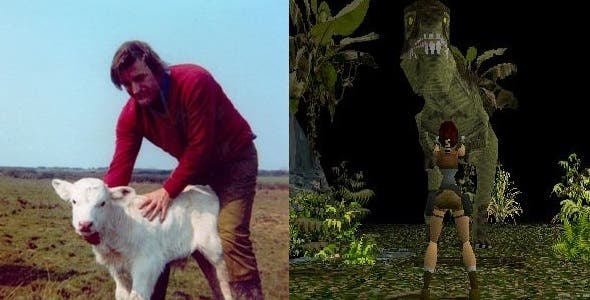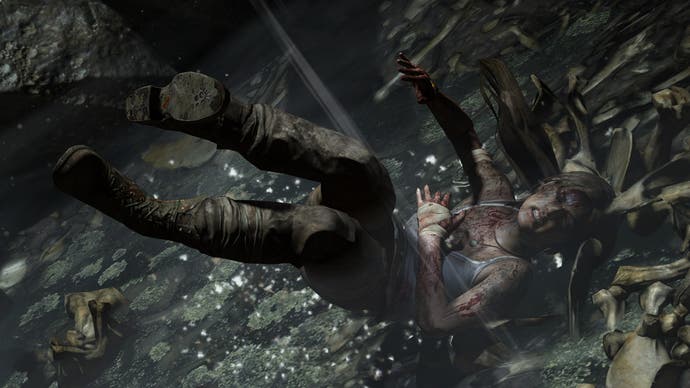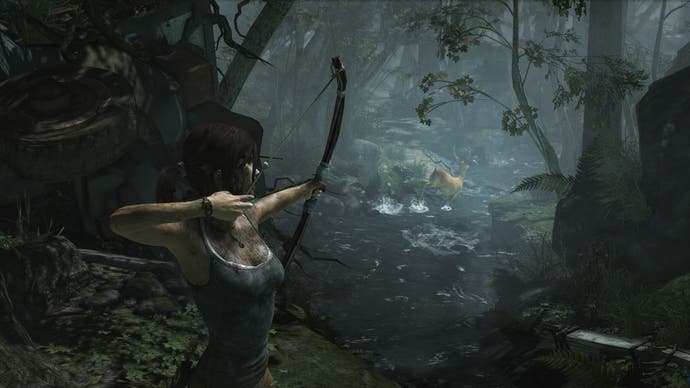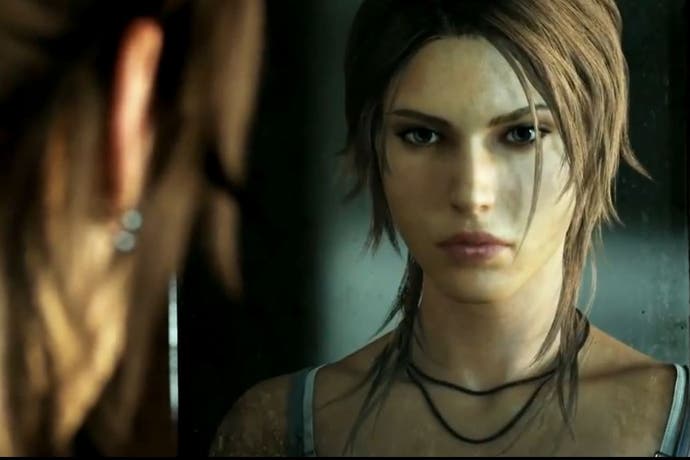Tomb Raider review
Follow the Moskva down to Gorky Park.
The Definitive Edition of Tomb Raider is released for Xbox One and PlayStation 4 this week. Digital Foundry will be looking at these versions in detail, starting with today's performance analysis. In addition, here's Ellie's review of the Xbox 360 version, first published on 25th February 2013. The game itself is largely unchanged, save for the inclusion of some minor DLC and voice and motion control options, so we're confident that this review applies to the Definitive Edition, too.
Come, young adventurer. Or, if you remember the original Tomb Raider games: come, adventurer. Down the narrow passage, through the great stone doorway, into the torchlit chamber. Tread with reverence, for this is the final resting place of gaming's fallen heroes.
Here lies BloodRayne, buried in her best leather waistcoat. Alongside, marked by a tattered elephant jockstrap, is the grave of Leisure Suit Larry. Over there are the fossilised remains of Gex the gecko, Bubsy the bobcat and Q*bert the whatever the heck Q*bert was. Soldiers all. Let us remember them with a moment's silence, ignoring the sound of Nintendo's scraping shovels and Sega doing unspeakable things to corpses.
Now, look to the sarcophagus with the thinnest layer of dust and push back the lid. Rummage through crumbling bones and you will find a pair of pistols, 47 first aid kits and a bra big enough to hold hamster balls. Here lies Lara Croft, deader than the first bat she ever shot in the face.

Tears will be shed, no doubt. Lara holds a special place in many people's hearts. She had a formative influence on a generation of female players, for whom Tomb Raider was the gaming equivalent of The Bell Jar. Come to think of it, that T-rex did look a bit like Ted Hughes.
But it's time to let old Lara go. Characters must be allowed to evolve. Series have to move on. Otherwise, what is left? A culture of stagnation, where creative expression suffocates under the weight of tedious nostalgia and moribund ideas. To put it another way, Carry On Columbus.
Fair play, then, to Tomb Raider developer Crystal Dynamics for trying something new. As explained in a succession of press releases relying heavily on the words "series reboot", "origin story" and "gritty", this game marks a fresh start for the franchise. It's a prequel of sorts, designed to explain how our heroine evolved from ordinary young woman into hardcore shark-punching badass. They could have called it Lara Croft: When Gap Years Go Wrong.

The game is set on a mysterious island, populated by mysterious inhabitants and peppered with mysterious caves, mysterious tombs, mysterious artefacts and mysterious crates. Lara finds herself shipwrecked, without much more than a Kendal mint cake and a load of mutilated corpses for company.
The first hour of play is pretty depressing. It's also embarrassing, unless you have thick walls or neighbours who will regard the noise as adding ambience to the violent pornographic film they're making. When Lara's not screaming, shrieking, panting or squealing, she's busy getting chased, groped and tied up. When she dies, it's with the kind of orgasmic groan that would make Ben Dover demand another take that's less over-the-top.
All this takes place against a background of mutilated bodies and ritual sacrifice. No spoilers here, because this is the case right from the start - there's no build-up to these elements, no hinting at horror about to be revealed. The gory imagery is so prevalent and overblown it soon loses any power to shock or scare. "Oh," Lara might say, if she were thinking out loud, "Another room full of flayed corpses and pools of blood. I wonder what's in that crate?"

Thankfully she does not do too much thinking out loud, unlike some video game characters (yes you, Alan). Lara's persona is mostly sketched out through interactions with other characters, and she comes across as likeable and believable. Shrieking aside, the script does a good job of depicting a character who possesses real inner strength, while being plausibly unnerved by the constant prospect of violent death.
It's a shame the other characters don't get much screen time, and are therefore unable to move beyond archetypes like Feisty Black Chick, Nerdy White Dude, Hot Asian Babe and Dirty Foreign Rapist of Unspecified Baltic Origin. The plot does move along at a decent pace and the characters have conversations that are about more than just exposition. However, it feels like there are two conflicting forces at work here - a story that wants to be told, and a game that wants keep reminding everyone it's a game.
The most obvious example of this occurs early on, after Lara performs her first kill. A short cut-scene shows her contemplating the gravity of what it means to take a human life, and realising she has crossed a threshold over which she can never return. The pathos of this moment is somewhat undermined by the fact she spends the next 10 minutes blasting away at everyone like a toddler in a water fight - one who has been promised extra biscuits for headshots.
Within a couple of hours Lara has overcome her moral qualms to the point where she's blithely hacking enemies to death with a pickaxe, mainly in the head. This kind of excessive violence may be common in video games but it feels incongruous here, alongside a storyline that's trying to be subtle and realistic. Despite the narrative's best efforts, the transition from ordinary innocent to violent murderer happens with about as much thoughtful discourse on conflicting moral complexities as there is in an episode of The Wright Stuff.

Combat remains the dominant component as the game progresses but thankfully, it improves in other areas. The tide of blood and gore subsides and Lara stops shrieking. There are some excellent exploration sections complete with satisfying routes, beautiful vistas and atmospheric tombs. The latter are mostly found by diverging from the main path, and solving the puzzles contained within them is voluntary.
This is a smart idea. Many of the puzzles are as tough as those in the old games, but the option to walk away means there's no risk of getting stuck and frustrated for six hours, like that time in Tomb Raider 3 with the key and the dead monkey. Also every other time in Tomb Raider 3.
There aren't many mandatory puzzles and they aren't too tricky. They involve a lot of ropes. For the first few hours of play, it feels like this core element of the series has been sidelined and dumbed down to a disappointing degree. But again, things look up as the game goes on. The puzzles crop up more regularly and get more challenging. It's just like old times as the game shuts up, calms down and gives Lara the breathing space to quietly work out the answers.
However, for every pretty view or pleasing puzzle, another prolonged bout of hiding behind walls and shooting things is waiting around the corner. It's as if the game is terrified the high-level intellectual thinking involved in working out how to open a door will tire the poor dim player out, so a bit more mindless violence gets chucked in for relaxation purposes.

There also seems to be a constant worry that the player is not being given enough Things To Do. So meaningless tasks are offered up endlessly - Find All the Vases! Collect All the Mushrooms! Burn All the Flags! There are so many diary pages and collectable objects lying about that the island feels like a rubbish dump for a deeply dull museum.
The multitude of menus via which the objects are curated don't help, and nor do the endless onscreen messages. It's hard to get about excited about "2 OF 3 CEREMONIAL FANS FOUND!", no matter how that sentence is capitalised or punctuated. I am not ashamed to reveal that my final tally reads "0% VASES". (Although I am proud to have managed "67% KANPO HERBS".)
It's plausible there are players out there who can indeed be bothered to crack open every crate. And it is possible to complete the game while skipping the collecting business. But the sheer volume of stuff makes it hard to ignore, and so it becomes an annoying distraction.

As does the way the game is always spitting out unnecessary rewards. Early on, there is a thrilling section where Lara manages to escape from a collapsing cave. As she emerges into the light the sun breaks through the clouds, the orchestra swells and the island is revealed in all its rugged beauty. It is a wonderful moment of relief and revelation, spoiled by an onscreen message shouting "ART GALLERY UNLOCKED MAIN MENU/EXTRAS".
This sort of thing happens a lot. It's like trying to enjoy a delicious meal in a restaurant while being constantly interrupted by the waiter: "Ah, I see Sir is enjoying his gravy. If you'd like to visit the kitchen, the chef has put together a short Powerpoint presentation on how it was prepared."
When the game is not throwing art galleries around, it is lobbing everything else in sight at the player in a desperate bid to be liked. XP, "Skill Points", weapon upgrades, "Salvage" (the obligatory arbitrary in-game currency, found in crates and used to purchase yet more weapon upgrades). It's hard to keep track of all this gubbins and even harder to care about it. I do not need to spend Skill Points on a Survivor Upgrade to get a little badge with a leaf on it. I left the Woodcraft Folk in 1993.
The extraneous offering to end all extraneous offerings is the game's multiplayer mode. It's fine. There is a choice of modes, all variations on old themes. The maps are well laid out, with plenty of fun hidey-holes and pathways. Everything works as it should, and as it does in dozens of other games. But the mode's existence just doesn't make sense thematically, and it doesn't fit with the rest of this already bloated game. It's the 54th layer of icing on a cake collapsing under the weight of seven thousand glacé cherries.
Yes, game series must be allowed to move on. Otherwise there would be no Mario 64, no Prince of Persia: The Sands of Time, no Jambo Safari Wii. The problem with Tomb Raider is not that it's trying to do something new. The problem is it's trying to do what everyone else is doing.
It succeeds in that aim. The boxes can be ticked, several times over - collectables, upgrade systems, big fat guns, blood and gore, pretty graphics, set pieces, boss battles, cut-scenes where the characters' lip movements almost match what they are saying, multiplayer modes, art galleries, quick-time events, more collectables. All of these tricks are pulled off with competence and polish.

But they're just tricks, and they leave little room for the elements that set Tomb Raider apart to shine. Beneath the noise there is an engaging story clamouring to be heard, and there are moments of true beauty, serenity and pathos fighting for attention. The game does get better as it goes on, and despite the distractions the last few hours are a pleasure to play. At the centre of it all is a brilliant character, still iconic but more human and believable than she's ever been before.
So goodbye, old Lara. Your time is up. Hello, new Lara. If you can stop hacking people to death for five minutes, we'll get along fine.









